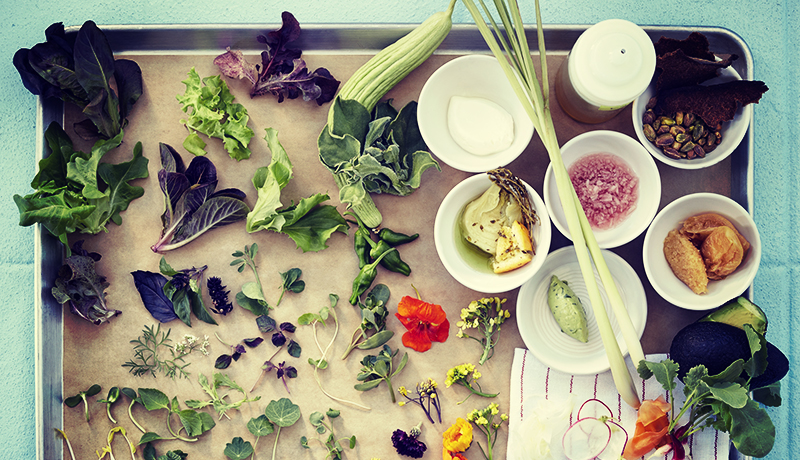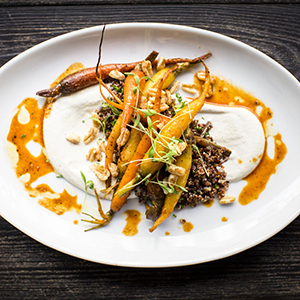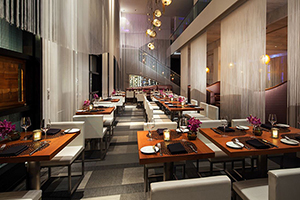

Al’s Place’s Bounty Of Greens
Photo Courtesy of Al’s Place San Francisco
Since Alice Waters’ career took off in the early 1970s, restaurants in the Bay Area have pioneered massive food trends such as the farm-to-table movement, whole animal cookery and slow food preparation.
The latest trend that San Francisco chefs are cooking up focuses on vegetables. As more and more people want to live healthy lifestyles, restaurants are following suit with plant-based dishes. Meat is no longer the most important part of a menu; instead, thoughtful and complex preparations of greens and okra have made their way into the spotlight.
What makes these hot spots so unique is that they are not strictly vegetarian or vegan restaurants — they are mainstream destinations establishing a whole new way of eating.
Al’s Place
Aaron London’s celebrated Mission District restaurant is a perfect example. As you read the menu — brine-pickled French fries with smoked apple sauce; General Leo’s cauliflower with mashed peas, burrata, pistachio mousse and rhubarb; grits with goat’s milk curds, eight-hour favas, yuzu blaster, secret peas and mint — the dishes sound so interesting you might not notice the absence of meat. Only when you get to the sides section do you remember that protein, like the duck with strawberry mole, was once considered an essential portion of every meal.
London’s flora-forward food is so flavorful and fresh that the restaurant is packed every night of the week — it’s one of the hottest tickets in town.
In an attempt to reduce waste, he’s taken the nose-to-tail concept one step further by avoiding composting in favor of using the entire vegetable — corn husks, carrot tops and kale stems can be used to impart natural earthy essence to everything from broth to mayonnaise.

The Keystone, Photo Courtesy of The Keystone San Francisco
The Keystone
Although he serves chicken and duck liver mousse and a dish of Korean pancakes filled with braised short rib, executive chef Banks White’s provocative vegetable dishes are crucial to a successful menu.
White spent a year eating vegan and, during that time, he realized how impactful it was for restaurants to offer vegetable dishes that moved beyond the stereotypical veggie burger. His choices are some of the most intricate we’ve ever tasted: The red quinoa and carrot salad with cashew cheese, serrano chili, crispy ancient grain, and the Berbere-spiced citronette are all knockouts; the green garlic gnocchi with wild mushrooms, grilled asparagus, parmesan, and sweet pea puree more than pleases the palate; and curried okra and eggplant with tomato, sweet potato, spinach, and coconut rice is another unexpected treat.
Cala
At her first U.S. restaurant, Hayes Valley’s Cala, Gabriela Cámara serves very few dishes at dinner that contain meat. (One is simply a salsa made from bone marrow.) Cámara, one of Mexico’s most renowned female chefs, constructed an entire menu of seafood and vegetable selections, and it’s some of the best Mexican food you’ll ever eat.
Quesadillas with greens, nettles and toma cheese are understated but wildly scrumptious. Salads packed with flavor feature different culinary techniques. Little gems are grilled and served with beans, while roasted poblano peppers are tossed with greens and crunchy pepitas. A sweet potato charred in ashes until it’s smoky and soft is a mind-blowing filling for hand-formed corn tortillas.
The Perennial
Anthony Myint and Karen Leibowitz’s latest project is The Perennial. The restaurant’s simple goal is to be the most sustainable eatery in the world. Leibowitz explains that they named their eatery after a type of plant “because perennial plants are so much better at storing carbon from the atmosphere in the soil.”
Everything about The Perennial attempts to change the way restaurants are operated by creating an entirely self-sufficient, closed-loop restaurant with little-to-no carbon footprint. They’ve made their own aquaponic greenhouse and have partnered with progressive farmers and ranchers for goods.
While there is meat on the menu, it takes a supporting role to chef Chris Kiyuna’s vegetable-based cuisine. Adventurous and mindful diners can enjoy strawberries with pickled Douglas fir tips, pumpkin seed bisque with crisp sunchoke, butter-poached asparagus with heritage polenta, and cauliflower gnocchi with morels, grilled apples and preserved Meyer lemon.

Trace, Photo Courtesy of Starwood Hotels & Resorts Worldwide Inc
And go ahead and ask the friendly staff about how the restaurant grows ancient perennial grains and maintains its zero-footprint practices — team members are more than willing to discuss the restaurant’s innovative projects.
Trace
Even large-scale restaurants run by national establishments are getting in on the action. For the entire month of June, Trace, the restaurant at W San Francisco, removed beef from its menu. Having a beef-free month was a way for the restaurant to encourage diners to change the way they eat.
“This is a humble exercise in changing our daily routines to have a positive impact on our community and the world around us,” executive chef Jason Rea explains. “As a sizable and very busy hotel, we are a large consumer of resources. We haven’t addressed all the issues causing climate change; however, it’s our hope to continuously review our daily practices and strive for ways to improve and make a difference. We want to ask questions like ‘How would our future change if we consume less resources?’”
A question we should all ask as we reach for the blistered squash rather than the seared steak.
